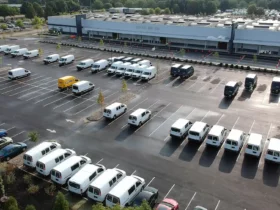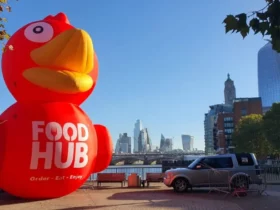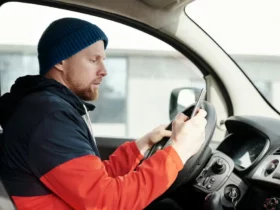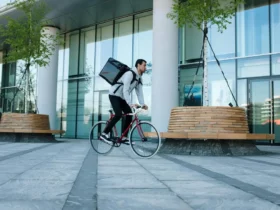Deciding to dive into the world of food delivery as a side hustle can be a game-changer. I’ve heard from fellow gig drivers across Canada that while Uber Eats can open doors to new opportunities, it’s not without its pitfalls. It’s a decision that’s got me weighing the good against the potentially not-so-good.
The flexibility to set my own schedule and the choice between delivering by car, bike, or scooter is pretty tempting. Plus, the app’s security seems solid, which is a big relief. But I’ve also got to consider my endgame. Partnering with Uber Eats means trusting them with my food, my service, and ultimately, my reputation.
And let’s not forget the bottom line – profit. With some of the highest fees in the industry, it’s crucial to think about whether the numbers really add up. Stick around as I delve into the pros and cons of joining the Uber Eats bandwagon.
Pros of Working for Uber Eats
Flexibility and Convenience
The beauty of working with Uber Eats is the incredible flexibility it offers. I’m impressed with the ability to set my own schedule and work when it’s convenient for me. Whether it’s during the weekdays, evenings, or weekends, the choice is mine. This allows me to fit work around my lifestyle rather than adjusting my life to fit a work schedule. Plus, there’s the convenience of choosing my preferred method of delivery. I can opt for a car, bike, or scooter, depending on what works best for me.
Earning Potential
Talking about earnings, I find the potential with Uber Eats quite attractive. Although the base pay may not always seem high, you can earn more through promotions, referrals, and peak periods. In fact, earnings can average $12 per hour and sometimes higher, especially with group orders which can bump that up to $20 an hour.
Easy and Inexpensive Withdrawal of Earnings
With Uber Eats, accessing my earnings is a breeze. I can cash out up to five times daily, which is handy if I need cash quickly. Best of all, for Chase Bank customers, this can be done up to $500 a day free of charge. It’s a relief knowing I won’t be waiting around for a fortnightly or monthly paycheck.
Relaxed Dress Code
I appreciate not having to fret over what to wear for work. The dress code with Uber Eats is non-existent, which means comfort is key. I can don my favorite T-shirt and jeans without issue, making the job less stressful.
Opportunity for Social Interaction
One of the subtle joys of delivering food is the interactions I get to have. While they’re brief, exchanges with restaurant staff and customers add a touch of social interaction to my day. It’s always a pleasure to meet new people and sometimes even a friendly pet at the customer’s door.
Fresh Air and Mobility
For anyone who loves being out and about, this job provides ample excuse to enjoy fresh air and stay on the move. Whether I’m zipping around on a bike or driving through new neighborhoods, I’m not stuck in a stuffy office, which does wonders for my mood and health.
Independence in Work
Another pro is the level of independence. I’m not constantly under the watchful eye of a boss during pickups and deliveries. It’s refreshing to be responsible for my own work without someone micromanaging every step.
Ease of Work
Finally, the job itself is quite straightforward. If you’ve got a smartphone and know how to use GPS, you’re set to learn the job quickly. There’s no extensive training required, and the absence of office politics is a breath of fresh air. Plus, with the Uber app guiding me, I’ve found it relatively easy to navigate my deliveries, which certainly makes the work less challenging than some other gigs out there.
Cons of Working for Uber Eats
Safety Concerns
One issue that can’t be ignored when delivering for Uber Eats is the potential safety concerns. High-crime areas pose a particular risk to drivers. Although I have the right to refuse any delivery, it’s not always apparent that a destination is unsafe until I get there. While Uber encourages driver safety and provides resources on their website, it’s ultimately up to me to contact dispatch if I feel threatened and prioritize my safety over completing a drop.
Risk of Accidents
As a delivery driver, I’m also exposed to possible accidents, especially when driving in poor weather conditions. Bald tires or lack of vehicle maintenance can lead to hazardous situations, like skidding on ice or collision risks. It’s essential I keep my car in top shape to minimize risks, but that doesn’t eliminate the chance of an unexpected accident occurring, which can be quite costly.
Traffic and Delays
Moreover, traffic and delays are an inevitable part of the job that can put a dent in my productivity. Instances like getting stuck behind a drawbridge or a train route can add significant time to deliveries. Even though I can update customers on these delays, they can lead to frustration for both parties and potentially impact my earnings if the customer decides to tip less as a result.
Unpredictable Earnings
Speaking of earnings, one of the biggest drawbacks is their unpredictability. While I can earn more during peak periods and through promotions and referrals, there’s heavy competition from other drivers also looking to maximize their income. Plus, outside of these bonuses, base delivery earnings can be low, and I often need to rely on customer tips that aren’t guaranteed.
Vehicle Wear and Tear
Lastly, the wear and tear on my vehicle is a never-ending concern. Regular driving for deliveries leads to faster deterioration of the car, from tires to brakes and engine components. And since all these expenses come out of my pocket, it’s a significant consideration when calculating my actual take-home pay.
Customer Experience with Uber Eats
App Usability
When it comes to navigating the Uber Eats app, I’ve found it to be user-friendly and intuitive. With a 4.6-star rating on both the App Store and Google Play, it’s clear I’m not alone in this assessment. The process is straightforward: open the app, tap the menu, select help, and you’re on your way to finding a solution or getting in touch with phone support if necessary. This degree of in-app support stands out and makes managing my deliveries a breeze.
Even when I’m super busy, like during a Friday night rush, the app’s streamlined design helps me stay on top of my game. Though I have to admit, at times, the interface could be a tad more forgiving, especially when it comes to accidental button presses on the tablet provided by Uber Eats, which can lead to minor mix-ups.
Delivery Times and Accuracy
Since I started delivering with Uber Eats, I’ve noticed that delivery times are usually on point. Sure, there are occasional delays, but generally, I can swoop into a restaurant and have the order ready within a few minutes, even if I am just around the corner. My customers often commend me on the accuracy and warmth of the food upon delivery, though there have been instances when things didn’t go as planned. A bad delivery experience, such as cold or damaged food, can really affect a customer’s impression, not just of me as the driver but the Uber Eats service as a whole.
Costs and Fees
Discussing costs, Uber Eats can be a bit of a double-edged sword for businesses. For some, it has led to a substantial 30% bump in sales, which implies that despite the fees, there’s tangible growth to be had. On the flip side, competing restaurants with cheaper prices can edge out others since customers tend to lean towards budget-friendly options. Keeping up with costs can be challenging for everyone involved, which is why it’s vital to stay current on fee structures and adjustments.
Cancelation and Refund Policies
Lastly, the navigation of cancelations and refunds can get tricky. In an ideal world, every order would go off without a hitch, but reality often begs to differ. If a customer needs to cancel or has an issue with an order, it’s not always straightforward to get a refund or correction. I’ve heard that some third-party delivery platforms can take a while to process changes, but with Uber Eats, my experience has shown that dealing with adjustments is more direct, and customer support is genuinely helpful, which rounds out the overall service positively.
Comparing Uber Eats with Other Food Delivery Services
Uber Eats vs. DoorDash
When I consider the rivalry between Uber Eats and DoorDash, I’m reminded of just how competitive the food delivery market has become. Uber Eats has secured a significant place with a 29% market share and a presence in over 6000 cities, yet DoorDash leads the pack in the US. My experience with both platforms reveals that driver earnings can be quite comparable after including tips.
DoorDash may appear to have an edge with slightly higher average earnings per hour, but this isn’t the whole story. Uber Eats provides me with the flexibility to work without preset hours and the choice of multiple delivery methods. DoorDash’s Storefront option, which caters to businesses wanting only online ordering without delivery, showcases its adaptability in meeting diverse needs.
| Platform | Earnings per Hour (Average) | Market Share | Unique Offering |
|---|---|---|---|
| DoorDash | Higher (not specified) | Largest in US | Storefront Option |
| Uber Eats | $10-$17 | 29% | Multiple Delivery Options |
For drivers like me, it’s all about weighing these factors against personal preferences and the specific dynamics of their local delivery market.
Uber Eats vs. Grubhub
As I shift gears to compare Uber Eats with Grubhub, there’s a lot that aligns between these two contenders. Grubhub boasts availability in over 4000 cities and partners with 265,000 restaurants. I’ve noticed that Grubhub is particularly dominant in New York, which may sway drivers there towards its platform.
They both allow for daily earnings withdrawals and emphasize the significance of keeping 100% of tips. However, Grubhub goes a step further with its direct order links, which help restaurants skip hefty marketing commissions.
| Platform | Presence | Partner Restaurants | Notable Features |
|---|---|---|---|
| Grubhub | Over 4000 cities | 265,000 | Direct Order Links, Popular in New York |
| Uber Eats | Over 6000 cities | Not specified | Broad Market Coverage |
Financially, the surface numbers tend to level out between Uber Eats and Grubhub for drivers, but it’s the finer operational details and regional preferences that make a difference.
Uber Eats vs. Postmates
When you talk about Uber Eats and Postmates, it’s like discussing family traits—they’re now part of the same family since Uber acquired Postmates. However, for those considering distinctions prior to the acquisition, Postmates was known for an eclectic mix of delivery items, including groceries and alcohol, alongside food.
While working for Uber Eats now, I enjoy the combined strength of both platforms’ technology and customer base. Postmates’ integration into Uber’s system means that I have access to a wider array of delivery options and potential earnings. While this consolidation may simplify choices for drivers, it’s also reshaped the landscape for how delivery services compete and serve their markets. Uber’s massive $83 billion revenue in 2021 is a testament to how potent such an amalgamation can be.
| Platform | Unique Aspect | Post-acquisition Benefit |
|---|---|---|
| Postmates | Diverse Delivery Options | Broadened Service Offerings |
| Uber Eats | Acquired Postmates | Enhanced Technological Capability, Larger Customer Base |
While Postmates operated under a different banner, its strengths have now been absorbed, giving Uber Eats an expanded toolkit with which to serve its users and contractors.
Conclusion
I’ve taken you through a journey exploring the nuances of working with Uber Eats. It’s clear that while there are several benefits to driving for the platform, there are also some drawbacks to consider. Whether you’re eyeing this gig for the flexible hours or the potential to maximize earnings through the expanded network, you’ve got to weigh these against the realities of the job. Every city has its own rhythm and what works in one might not in another. If you’re considering diving into the world of food delivery with Uber Eats, remember to take into account your personal circumstances and the local market. Here’s to making informed choices, and maybe I’ll see you on the road!
FAQ – Frequently Asked Questions
Are there any costs associated with working for Uber Eats?
Yes, drivers need to cover their own vehicle maintenance, fuel costs, and any other related expenses.
Can I choose the area I want to deliver in with Uber Eats?
Drivers can choose their preferred area to work in, but the availability of orders and earnings potential may vary between different areas.













